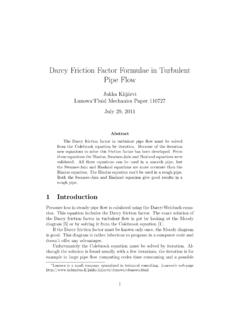Transcription of Mars outflow channels: A reappraisal of the estimation of ...
1 Mars outflow channels: A reappraisal of the estimation of water flowvelocities from water depths, regional slopes, and channel floorpropertiesLionel WilsonPlanetary Science Research Group, Environmental Science Department, Lancaster University, Lancaster, UKGil J. Ghatan and James W. Head IIIG eological Sciences Department, Brown University, Providence, Rhode Island, USAKarl L. MitchellPlanetary Science Research Group, Environmental Science Department, Lancaster University, Lancaster, UKReceived 19 April 2004; revised 25 June 2004; accepted 14 July 2004; published 10 September 2004.
2 [1]Methods used so far to assess the flow velocities of the water commonly assumed tobe responsible for forming the major outflow channel systems on Mars have relied widelyon various versions of the Manning equation. This has led to problems in allowing for thedifference between the accelerations due to gravity on Mars and Earth and for thedifferences of scale between Martian floods and most river systems on Earth. Wereanalyze the problem of estimating water flow velocities in Martian outflow channelsusing equations based on the darcy -Weisbach friction factor instead of the Manningnfactor.
3 We give simplified formulae appropriate to Mars for the darcy -Weisbach frictioncoefficient as a function of bedrock size distribution. For a given channel floor slopeand water flood depth, similar mean flow velocities are implied for a wide range of valuesof the ratio of bed roughness to water depth relevant to Martian outflow channels. Using arecent rederivation of Manning s equation based on turbulence theory, we obtain anew value of s m 1/3for the Manningncoefficient appropriate to Martian channelsand show that previous analyses have generally overestimated (though in some casesunderestimated) water flow velocities on Mars by a factor of order two.
4 Combining theconsequences of this flow velocity overestimate with likely overestimates of flow depthfrom assuming bank-full flow, we show that discharges may have been overestimatedby a factor of up to 25, leading to corresponding overestimates of subsurface aquiferpermeabilities, rates of filling of depressions with water, and grain sizes of sediments onchannel floors. Despite the availability of an improved value for the Manningncoefficientfor Mars, we strongly recommend that modified forms of the original version of theManning equation should be replaced by the modern form or, preferably, by theDarcy-Weisbach equation in future :6225 Planetology: Solar SystemObjects: Mars; 1829 Hydrology: Groundwater hydrology; 1860 Hydrology: Runoff and streamflow; 1815 Hydrology: Erosion and sedimentation; 5415 Planetology: Solid Surface Planets: Erosion and weathering.
5 KEYWORDS:Mars, outflow channels, waterCitation:Wilson, L., G. J. Ghatan, J. W. Head III, and K. L. Mitchell (2004), Mars outflow channels: A reappraisal of the estimationof water flow velocities from water depths, regional slopes, and channel floor properties,J. Geophys. Res.,109, E09003, Introduction[2] The discharge rates and volumes of fluids responsiblefor carving the Martian outflow channels are of significantimportance for understanding both the source of the fluid andits evolution on the surface of Mars. If, as generally accepted(see discussions byCarr[1979] andBaker[2001]), thechannels were formed by release of water from the subsur-face, then they carry implications for the volumes and releaserates of that water, and hence the availability of water as aliquid, as a function of time on Mars.
6 If, on the other hand, thechannels are the result of releases of liquid carbon dioxide orcarbon dioxide-water mixtures resulting from decompositionof clathrates [ ,Milton, 1974;Hoffman, 2000], then thereare equally important implications for the volatile content andthermodynamic state of the Martian subsurface. For thepresent purpose we assume that water is the sole agentJOURNAL OF GEOPHYSICAL RESEARCH, VOL. 109, E09003, , 2004 Copyright 2004 by the American Geophysical $ for the erosion of the channels, on the basis ofarguments about the thermodynamics of the formation ofclathrates [Stewart and Nimmo, 2002] and the behaviorof carbon dioxide liquid released into the current Martiansurface environment [Wilson and Head, 2002] (though theanalysis that follows would be applicable to any low-viscosity liquid).
7 [3] Most attempts to estimate the discharges ( , watervolume fluxes) of the Martian outflow channels haveemployed the empirically derivedManning[1891] equation expresses the influence of bed roughness andsediment transport in channels through a single parameter,the Manning coefficient,n, which has the dimensions of timedivided by length1/3. The Manning equation does not havethe simplest functional form that can be derived fromdimensional analysis and also (as is the case with the equationdue to Che zy [Herschel, 1897]) does not explicitly includethe effect of the acceleration due to gravity.
8 Attempts havebeen made by various authors in the planetary community toallow for the difference between the accelerations due togravity on Mars and Earth but, even when done correctly, thisdoes not eliminate all problems. In addition to the accelera-tion due to gravity, the Manning coefficient involves a lengthscale that has been shown in a recent development byGioiaand Bombardelli[2002] to represent the scale of bed rough-ness, and thus even when the differing gravities are taken intoaccount, use of the resulting Manning coefficient may not beappropriate on Mars unless the bed roughness in Martianoutflow channels is generally similar to that in the terrestrialrivers from which values of the Manning coefficient arederived.
9 Alternative equations describing flow through openand closed conduits have been available for more than acentury, and the American Society of Civil Engineers [ASCETask Force on friction factors , 1963] recommends theadoption of the darcy -Weisbach equation, which utilizes anempirically determined nondimensional friction coefficient,as the optimal approach to understanding flow of water over awide range of conditions. The nature of this issue for Marswas clearly described byKomar[1979] in an important paperlargely ignored by later workers.
10 Here we reiterate the casefor the need for a transition in the methods employed by theplanetary community to estimate channel discharges: use ofthe original versions of the Manning and Che zy equations,and of their ad hoc modifications, should preferably bereplaced by use of the darcy -Weisbach equation. If aManning-type approach is used it should employ the newdevelopment byGioia and Bombardelli[2002], whichreplaces the original Manning coefficient,n, with a new,dimensionless coefficient,K, and explicitly includes gravityand channel floor roughness within the equation.









